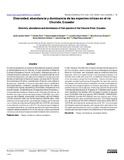Diversidad, abundancia y dominancia de las especies ícticas en el río Churute, Ecuador

Visualizar/
Data
2023Autor
Palabras Clave
Tilapia, Ictiofauna, Índices ecológicosTilapia, Ichthyofauna, Ecological indices
Metadatos
Mostrar registro completoResumo
En esta investigación se evaluó la diversidad de especies nativas
e introducidas en el río Churute, el cual atraviesa la Reserva
Ecológica Manglares Churute, en Ecuador, utilizando para ello un
enfoque empírico-inductivo, con diseño no experimental de corte
transversal-explicativo. Las capturas se realizaron con atarraya, arte
de pesca tradicional en época de sequía, a lo largo del río Churute.
Se muestrearon 25 sitios, considerando 33 lances como esfuerzo
de pesca por cada sitio, y los peces capturados fueron clasificados
taxonómicamente, contados y pesados para estimar los índices
ecológicos de riqueza, abundancia, diversidad y dominancia en el
área de estudio. Se identificaron 20 especies ícticas (19 nativas y 1
introducida) distribuidas en 18 géneros de 13 familias y 5 órdenes; las
familias con mayor número de especies fue CICHLIDAE con cuatro
especies, BRYCONIDAE, CHARACIDAE, ELEOTRIDAE y HEPTAPTERIDAE
con dos especies cada una. De las especies identificadas, siete
calificaron como importantes, sobresaliendo la tilapia, pez introducido
con un Índice de Importancia Relativa (IRI) de 40.075,58, dominando
en los sitios de muestreo en un 61,13 %. Se concluye que la tilapia es
una especie dominante, con tasas de reproducción superiores al de las
especies nativas presentes en el río Churute, por lo que su presencia
constituye una seria amenaza a la biodiversidad de este ecosistema.
Colecciones
Información Adicional
| Otros Títulos | Diversity, abundance and dominance of fish species in the Churute River, Ecuador |
| Correo Electrónico | janeth.jacome@uleam.edu.ec |
| Editor | SaberULA |
| ISSN | 0798-2259 |
| ISSN Electrónico | 2477-944X |
| Resumen en otro Idioma | In this research, the diversity of native and introduced species in the Churute River, which crosses the Churute Manglares Ecological Reserve, in Ecuador, was evaluated using an empirical-inductive approach, with a non-experimental cross-explanatory design. The catches were made with cast nets, a traditional fishing technique in the dry season, along the Churute River. Twenty-five sites were sampled, considering 33 sets as fishing effort for each site, and the fish caught were taxonomically classified, counted, and weighed to estimate the ecological indices of richness, abundance, diversity, and dominance in the study area. Twenty fish species (19 native and 1 introduced) distributed in 18 genera of 13 families and 5 orders were identified; the families with the highest number of species were CICHLIDAE with four species, BRYCONIDAE, CHARACIDAE, ELEOTRIDAE and HEPTAPTERIDAE with two species each. Of the identified species, seven qualified as important, with tilapia standing out, an introduced fish with a Relative Importance Index (IRI) of 40,075.58, dominating the sampling sites by 61.13%. It is concluded that tilapia is a dominant species, with reproduction rates higher than the native species present in the Churute River, therefore its presence constitutes a serious threat to the biodiversity of this ecosystem. |
| Colación | 1-9 |
| País | Venezuela |
| Institución | Universidad del Zulia (LUZ) Universidad de Los Andes (ULA) |
| Publicación Electrónica | Revista Científica |
| Sección | Revista Científica: Artículos |





